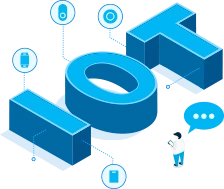Beacons are wireless transmitters that use low-energy Bluetooth technology to send signals known as BLE to nearby smart devices. Bluetooth beacons are installed at different locations and send push notifications to the customers on their cellphones. The push notification has content related to the person’s current location. The purpose of iBeacon technology is to enhance marketing and better customer experience.
You are here because you want to learn iBeacon technology. This article will guide you about different aspects of this amazing technology such as its setup requirements, working, and advantages.
What is an iBeacon device
Most of the time, beacon and iBeacon terms are used interchangeably. However, iBeacon is basically a trademarked term used by Apple for its location-aware system. It allows different mobile apps running on different Android and iOS devices to receive signals from this device in the physical world.
This device sends push notifications that contain useful information on the basis of the customer’s current location. It uses Bluetooth Low Energy(BLE) for its communication.
Core components of an iBeacon system
For iBeacon technology to function effectively, there are some key components that need to work together. An iBeacon system requires the following core components to work well:
iBeacon transmitters
- The iBeacon transmitter is a small wireless device that is fixed in a place to broadcast Bluetooth Low Energy (BLE) signals.
- It can be placed on walls, ceilings, shelves, etc., and transmits signals containing a unique ID.
Compatible receiving devices
- The receiving device needs to have Bluetooth Smart capability to detect iBeacon signals.
- It should be running a compatible version of the iOS or Android operating system.
- Most modern smartphones have built-in Bluetooth that can work with iBeacons.
Apps to detect and act on iBeacon signals
- A specialized app is required on the receiving device to continuously scan for and detect iBeacon signals.
- The app determines proximity based on signal strength and triggers appropriate actions like notifications.
- Apps can be created using iBeacon frameworks like Core Location on iOS or third-party SDKs.
User location permissions
- For the app to detect iBeacon signals, users need to grant location permission.
- This allows the app to constantly scan for nearby iBeacon devices and determine proximity.
- Permission is critical for iBeacon functionality, without it the app cannot detect signals.
It is important to note that smartphones don’t trigger actions themselves based on proximity to beacons. Specific app installed on these devices detects beacons by using different APIs such as Estimote SDK or some other native frameworks by Apple. A complete BLE-compatible list is available on the Bluetooth official site so you can verify your device there.
How does iBeacon technology work
The iBeacon devices are attached to walls or placed at fixed locations. iBeacon transmitters broadcast Bluetooth Low Energy (BLE) signals at regular intervals, even when no receiving device is in range.
![]()
iBeacons broadcasting signals
These transmitted signals contain a Universally Unique Identifier (UUID), major value, and minor value to identify each iBeacon. The UUID indicates which organization the beacon belongs to, while the major and minor values distinguish individual beacons. The transmission power of the BLE signals is calibrated so that the signal strength can estimate the proximity distance – stronger signals mean closer distance.
Apps detecting and acting on iBeacon signals
On receiving devices like smartphones, specialized apps continuously scan for these BLE signals in the background. When the app detects an iBeacon signal, it extracts the UUID, major, and minor values from the transmission. Using the signal strength (RSSI), the app estimates how far away the device is from the iBeacon. With the UUID and major/minor values, the app identifies the specific iBeacon that was detected. If required, the app can then trigger appropriate actions like push notifications or information pop-ups based on rules for that iBeacon. Without a relevant app, it is not possible to catch the iBeacon broadcasts.
iBeacon signal identifiers – UUID, Major, Minor, Tx Power
The iBeacon standard uses BLE signals to broadcast identifying information to nearby devices. There are 4 main identifiers contained in each iBeacon transmission:
Unique Universal Identifier – UUID: This is basically a 16 bye string that gives a unique identity to the iBeacon. For example, if Coca-Cola has a network of beacons in the grocery store, all beacons belonging to Coca-Cola have the same UUID code. This unique identifier contains general information related to the beacon such as who owns it and which business owns it.
Major: This is basically a two-byte string that is used to identify a smaller subset of beacons uniquely within the larger group. For example, if Coca-Cola utilizes 4 beacons in a specific grocery store, all 4 beacons would contain the same major. It helps Coca-Cola to know the exact location of its customers in the specific store.
Minor: This is also a two-byte string that helps to identify beacons individually. Let’s take the Coca-Cola example again. There are 4 beacons in the one grocery store. All 4 beacons have a unique minor. So minor helps a company to uniquely identify the exact location of a customer inside the store.
Tx Power: It provides the proximity distance of the customer from the beacon. How does Tx Power work? Tx power determines the strength of the signal exactly 1 meter from the beacon device. It is hardcoded and calibrated in advance so devices use this as a baseline and provide the estimated distance of the user.
The key difference between iBeacon and Eddystone
iBeacon and Eddystone are both Bluetooth Low Energy (BLE) beacon protocols that have some key differences.
![]()
Technology: iBeacon technology is basically a beacon protocol developed by Apple, so Apple controls its all specifications. iOS 7 or later versions support this protocol and allow iPads and iPhones to scan for different Bluetooth devices nearby. On the other hand, Eddystone beacons are open-source beacons that can be manufactured by any business at an affordable price. Anyone can use the specification from GitHub.
Compatibility: iBeacon is compatible with Android and iOS but it is native only for iOS. However, Eddystone is compatible with Android, iOS, and all platforms that have support for BLE beacons.
Ease of Use: iBeacon is extremely easy to implement. However, Eddystone is much more flexible and requires more coding for integration. Actually, different companies develop beacons with Eddystone in their own way so it can be complicated.
Usage: In iBeacon, UUIDs, a specific code, have a link with the developer’s server. When this code is sent to any smartphone, the device requires a special app to perform a special task after receiving the code. So it requires an app for proper work. On the other hand, Eddystone uses a URL instead of UUID so that users can open that easily in the browser. So it doesn’t require any app for its working.
Security and Privacy: iBeacon transmits its signal publically. Anyone can easily detect it by using iOS devices. Moreover, there are different apps available for both Android and iOS that can detect UUID code. So it is not very secure. However, Eddystone has a feature known as an Ephemeral Identifier that allows beacons to send a signal such that only authorized clients can identify that signal.
API: As iBeacon is proprietary software it doesn’t contain a specific API. However, Eddystone is an open-source and its API is available for open use.
Overall, both beacons have some pros and cons so you can pick any of them according to your needs. If you want to develop your own beacon, you will definitely go for Eddystone because it is open-source.
Compatible devices and OS versions for iBeacon
For iBeacon technology to work, the receiving devices and apps need to have compatibility with the iBeacon protocol. The key factors that enable iBeacon communication are proper hardware, OS version, location permissions, and an integrated app. Here is an overview of compatibility considerations for iOS and Android:
iOS devices compatible with iBeacon
- iBeacon requires iPhones, iPads, or iPod Touch models with Bluetooth 4.0 or later. This includes iPhone 4S or newer.
- For full microlocation and background detection features, iOS devices need iOS 7 or later. Earlier iOS versions have limited support.
- Users have to grant location permission to apps for the detection of iBeacons.
Android devices compatible with iBeacon
- Most modern Android smartphones support iBeacon communication at the hardware level.
- For software, Android 5.0 Lollipop or later is recommended for good iBeacon integration. Earlier Android OS versions have limited support.
- No special hardware is needed, but the device’s Bluetooth must be turned on to detect iBeacons.
Apps required for iBeacon interactions
- On both iOS and Android platforms, a specialized app with iBeacon support is required.
- Many third-party apps provide iBeacon detection and integration capabilities out of the box.
- For custom apps, native iOS or Android iBeacon APIs can be used to build iBeacon functionality.
- The apps must ask for user location permission along with Bluetooth access.
Real-world iBeacon applications and use cases
iBeacon technology plays a significant role in marketing strategies. Here are some of the common use cases of iBeacon technology across different industries:
Micro-location and indoor navigation: iBeacons can provide accurate location data indoors where GPS often fails. Apps can use iBeacons to guide users through museums, airports, grocery stores, etc.
Proximity marketing and notifications: Stores can send customers notifications about deals and recommendations as they enter different departments. Museums can provide more info about exhibits near a user’s location.
Asset tracking: iBeacons placed on equipment and inventory can track their movement and location in warehouses, offices, etc. Staff can quickly locate shared resources.
Attendance monitoring: Schools and events can take attendance by detecting when people enter/leave an iBeacon zone. This is done anonymously without needing user check-ins.
Contactless payments: iBeacons enable location-based mobile payments. Rather than needing to open an app, payments can happen automatically as a user moves through a store.
With accurate micro-location sensing and the ability to trigger contextual notifications, iBeacons open up many new proximity-based applications. Retail, events, transportation, manufacturing, and many other industries can benefit from this versatile technology.
How much energy does an iBeacon consume
Beacons are basically standalone devices that utilize batteries for working. So it is extremely important to have an idea about iBeacon energy consumption. Therefore, a question arises here: How long does a beacon work until its battery leaves functioning? Well, as we have already mentioned these devices work on Bluetooth Low Energy, so it’s optimistic that they don’t consume much energy.
Roughly, an average beacon can work for at least an entire year and doesn’t require battery replacement. Moreover, battery life also depends on the type of beacon. For example, our M1 coin beacon offers a 16-month battery life, while the M3 industrial beacon has a battery life of up to 20 years.
How secure is the iBeacon protocol
There is a question mark on the security of the iBeacon protocol. Keep in mind that this protocol doesn’t provide any security at all. Basically, it is extremely easy to scan your beacon IDs. Therefore, if you find out UUID, Major, and Minor strings or IDs, you can simply clone that beacon, by assigning its current parameters to another beacon device or emulate that by utilizing your smartphone. Although all smartphones are not capable of emulating beacons, this number will be increased in the future.
It would be much better not to use iBeacon technology to exchange sensitive data. Let’s understand the security of this device by taking a hypothetical situation. Let’s say, you use this device to open your gate. Someone from your authorized staff scans his or her beacon to come in or out. As you know the beacon range is approximately 30 meters on average, so it means an offender can easily create a beacon key identical to the original one by sitting somewhere besides your home or office. So by using that key, he can open the door.
You might be thinking how does the offender get beacon IDs? It’s not a big deal. There are different apps available that give you this functionality. These applications give all of the beacon’s information in a specific range.
How to protect iBeacon technology security
Is there any way to protect iBeacon security? Well, beacon technology is getting advanced day by day. Now different companies are intending to secure beacons with passwords so no hijacker can send notifications to the customers. Still, we recommend you not use beacons for your sensitive information. Moreover, you should purchase this device from a trustworthy beacon manufacturer such as MOKOSmart.
CONTINUE READING ABOUT IBEACON





























